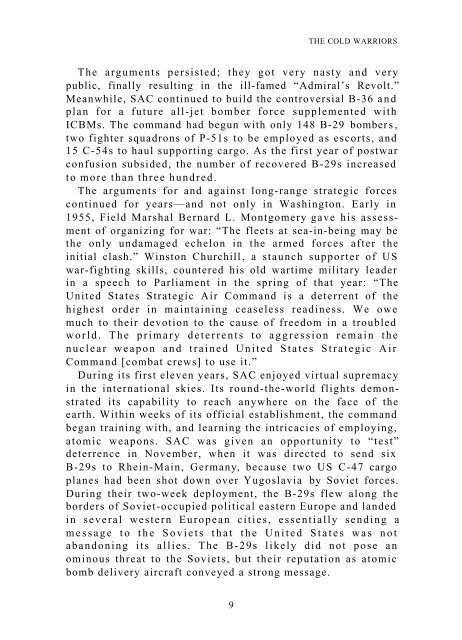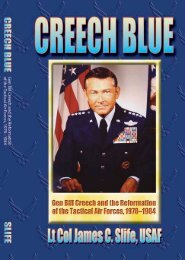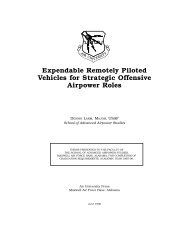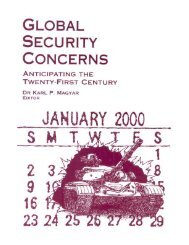Inside the Cold War - Project Gutenberg Consortia Center
Inside the Cold War - Project Gutenberg Consortia Center
Inside the Cold War - Project Gutenberg Consortia Center
Create successful ePaper yourself
Turn your PDF publications into a flip-book with our unique Google optimized e-Paper software.
THE COLD WARRIORS<br />
The arguments persisted; <strong>the</strong>y got very nasty and very<br />
public, finally resulting in <strong>the</strong> ill-famed “Admiral’s Revolt.”<br />
Meanwhile, SAC continued to build <strong>the</strong> controversial B-36 and<br />
plan for a future all-jet bomber force supplemented with<br />
ICBMs. The command had begun with only 148 B-29 bombers,<br />
two fighter squadrons of P-51s to be employed as escorts, and<br />
15 C-54s to haul supporting cargo. As <strong>the</strong> first year of postwar<br />
confusion subsided, <strong>the</strong> number of recovered B-29s increased<br />
to more than three hundred.<br />
The arguments for and against long-range strategic forces<br />
continued for years—and not only in Washington. Early in<br />
1955, Field Marshal Bernard L. Montgomery gave his assessment<br />
of organizing for war: “The fleets at sea-in-being may be<br />
<strong>the</strong> only undamaged echelon in <strong>the</strong> armed forces after <strong>the</strong><br />
initial clash.” Winston Churchill, a staunch supporter of US<br />
war-fighting skills, countered his old wartime military leader<br />
in a speech to Parliament in <strong>the</strong> spring of that year: “The<br />
United States Strategic Air Command is a deterrent of <strong>the</strong><br />
highest order in maintaining ceaseless readiness. We owe<br />
much to <strong>the</strong>ir devotion to <strong>the</strong> cause of freedom in a troubled<br />
world. The primary deterrents to aggression remain <strong>the</strong><br />
nuclear weapon and trained United States Strategic Air<br />
Command [combat crews] to use it.”<br />
During its first eleven years, SAC enjoyed virtual supremacy<br />
in <strong>the</strong> international skies. Its round-<strong>the</strong>-world flights demonstrated<br />
its capability to reach anywhere on <strong>the</strong> face of <strong>the</strong><br />
earth. Within weeks of its official establishment, <strong>the</strong> command<br />
began training with, and learning <strong>the</strong> intricacies of employing,<br />
atomic weapons. SAC was given an opportunity to “test”<br />
deterrence in November, when it was directed to send six<br />
B-29s to Rhein-Main, Germany, because two US C-47 cargo<br />
planes had been shot down over Yugoslavia by Soviet forces.<br />
During <strong>the</strong>ir two-week deployment, <strong>the</strong> B-29s flew along <strong>the</strong><br />
borders of Soviet-occupied political eastern Europe and landed<br />
in several western European cities, essentially sending a<br />
message to <strong>the</strong> Soviets that <strong>the</strong> United States was not<br />
abandoning its allies. The B-29s likely did not pose an<br />
ominous threat to <strong>the</strong> Soviets, but <strong>the</strong>ir reputation as atomic<br />
bomb delivery aircraft conveyed a strong message.<br />
9






